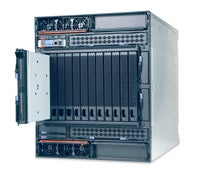 |
IBM BladeCenter HT Source: IBM |
IBM and Rackable Systems Monday announced a joint sales agreement under which Rackable Systems will offer IBM’s BladeCenter systems for installation inside of Rackable’s ICE Cube modular data centers.
IBM BladeCenter systems can now be installed inside of Rackable ICE Cube modular data centers.
The ICE Cube is a standard-size shipping container with all of the racks for an ultradense data center installed inside. Customers can fill it with Rackable’s line of 1U to 9U racks or they can add a BladeCenter chassis to use IBM blades.
The deal involves the use of IBM BladeCenter T or HT systems, which are NEBS-3/ETSI-compliant, meaning they’re certified for use in telecommunications environments and carrier facilities.
Pund-IT Principle Analyst Charles King said it’s a win for both companies. “It gives Rackable a way to jump into the blade solution space without having to spend any money developing it themselves,” he said, adding that developing the blades is an expensive process. “And it allows IBM to sell BladeCenter as an OEM product — not that Rackable will put its logo on it.”
|
Related Articles
» Dell Flexes Its Muscle to Enable Rapid Blade Provisioning » Hitachi Sharpens New Blade Servers Read More About Blades |
Tony Carrozza, senior vice president of sales and marketing for Rackable, said adding the BladeCenter products to the its modular data center “puts us in a position to offer customers a broader set of solutions, from cloud computing to enterprise apps, which is what the BladeCenter allows us to do going forward,” said
IBM blades are inherently different from Rackable rack-mounted systems. IBM blades are for more general-purpose computing, whereas Rackable systems are meant for ultradense computing projects.
“We don’t have what you would consider to be a true blade product,” Carrozza told InternetNews.com. “The BladeCenter is a true blade product with a self-contained fabric, management software, redundancy and resiliency in it,” he explained, adding that besides rack servers Rackable typically offers scale-out servers. “It’s blade like but doesn’t have its own switching fabric built into the chassis,” he said.
Plus, Rackable’s systems are based on Intel and AMD chips, whereas IBM blades also offer the option of IBM’s POWER5 and POWER6 processors.
|
Unsure About an Acronym or Term? |
The ICE Cube is available in 20- or 40-foot container sizes and can hold up to 1,344 dual-socket blades with quad-core Intel Xeons or 672 quad socket, dual-core AMD Opteron blades.
The BladeCenter chassis slots right into a Rackable ICE Cube, so long as you remember to remove the wheels that are on the chassis. It then uses the ICE Cube power and cooling system for operation and management.
IBM BladeCenter T and HT are available immediately via Rackable Systems and its channel partners.
Open Source Blades?
Rackable also announced it’s joining Blade.org, the industry consortium created in 2004 by IBM and Intel that’s trying to create open standards for blade servers. Up to now, all of the blades from Hewlett-Packard, Dell and Sun have used their own design standards, meaning you can’t install a Sun blade in an HP chassis, for example.
IBM has been an exception to that rule, opening its blades up and making the specs public. The first company to offer a third-party product is Themis, which offers a Sun UltraSPARC-based blade that works in a BladeCenter chassis.
“Openness has been a key part of our strategy for blades from day one,” said Tim Dougherty, director of BladeCenter strategy at IBM. “We felt it’s the right thing to do to expand the blade market.”
This article was originally published on InternetNews.com.


